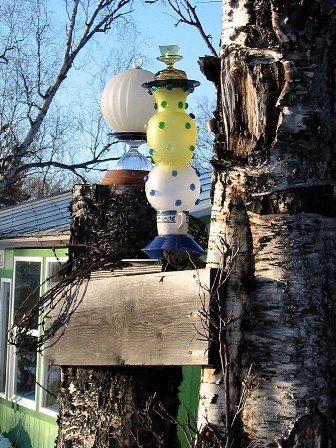DD Two is out of hibernation and picking green plant materials out of her ears! Hello, dears. Yes, I'm back. And I'm up to my ears in little green growing things in the greenhouse. It is sooo nice not to have to shovel snow anymore, isn't it? To heck with sunscreen! I just want to fluff up my pineal gland and make like a lizard in the sun. Even the mud looks good these days.
Believe me, it beats working on my computer and trying to figure out what ails it. Maybe a nice dose of 'If you don't start working right, I'm going to take you to the dump,' might do the trick. Ah, technology. I yearn for simpler days . . . right. Like I want to spend hours at the library and days waiting for a book loan to come through! Okay. The computer can stay. Anyway, I'm going to start uploading some of this spring's columns, so, hold on to your seats . . . Biennials - Garden Divas Worth Waiting For
Last week, my Irish cousin Sue, emailed me some old black and white photos of my father’s family. They were black and white, but, the memories they evoked were all in color. The huge blue green hydrangeas with orange tiger lilies leap frogging through them, and the neat clipped privet edging in a tiny knot garden were grandma’s little bit of England in the middle of Milford, Connecticut. Growing up in Miami, I was used to huge blowsy hibiscus hedges, mangoes dripping from trees, and white and mauve orchid-like flowers in banyan trees where we climbed like monkeys and chased after chameleons. A tropical paradise I took for granted, for all I wanted were the cool weather gardens of the English persuasion. Ah, youth. Now all I want is for spring to change winter’s coat for something in a lime green, neat, no rocks.

English biennial Forget-me-not 'Ultramarine'
While our zone three gardens grow tall stately delphiniums, bell-flowered campanulas, and blue poppies that any English gardener would kill for, the true stars of the cottage gardens are the ones we rarely grow anymore - the old-fashioned biennials. Patience is required for the full effect of these divas as they only give us a peek at their wares in the first year of growth. Hollyhocks have huge crinolines of round velvet leaves that tower over the Sweet Williams and Forget-me-nots with their neat mounds of green flushed with bronze. English daisies make prim rosettes of shiny green almost good enough to eat. And Angelica gigas taunts with her bold voluptuous divided leaves of deep green and maroon. Teases, the lot of them. Think of them as the salad before the entree.
Black Hollyhock with Sunflower and Sweet Peas.

The real show is worth the wait. With tall spikes of hibiscus-like flowers from white, pink, and rose to peach, yellow, and near black, the hollyhocks make a great foil for campanulas, geraniums, annual poppies, bachelor buttons, cosmos, and Nicotiana. My black hollyhock looked marvelous paired with a gold Provencal sunflower threaded through with a pink-white sweet pea. The bumblebees loved it, too. Their large seed heads look like cheese wheels and are easy to dry and save.
Many biennials are just perennials that need a new set of threads by year three. Fortunately, they produce lots of seed so they tend to naturalize or ‘volunteer’ in your garden so they’ll always be with you. Some of them are quite promiscuous and cross with themselves and their near cousins to make new colors and sometimes whole new varieties. Pansies and violas do that. What was once a black viola is now a black wine viola with yellow speckles knee deep in the pavers. Some of them are rather large, so I know there’s a pansy lurking in the DNA.

Sweet Williams 'Purple Oeschberg' and 'Dunnetti's Crimson'
with Lady's Mantle and Campanulas
My first Sweet Williams were planted firmly in the middle of my eighth birthday cake. They were the hit of the party. Mom and I drove down Dixie Highway to the local flower nursery and I picked out the most Englishy looking flowers they had. Mmm, they smelled just like cloves and allspice. They were perfect in the middle of a vanilla tube cake with real butter cream frosting. No cans. No boxes. Just the real cake ma’am. Sweet Williams are still my favorite flower. There’s nothing like their lush mounds of deep wine red and rich violet flowers set among the acid green clouds of Lady’s Mantle to light up the early summer garden. They are nature’s perfect cut flowers and perfume the garden all summer long.
Biennials are hard to find in nurseries these days since customers tend to only buy plants that are already in bloom. But, they are very easy to grow from seed. If you can baby them through the vagaries of an Alaskan winter, they’ll reward you with a show that’ll knock your socks off. The trick is convincing them to stay the winter. Hollyhocks have deep tap roots that freeze out if the soil’s too heavy and wet. You need to know the idiosyncrasies of your garden - is it protected with sufficient snow cover and well-drained? Give first year biennials a warm sunny spot and plump up the bed with plenty of compost, alfalfa meal, and bone meal so they’ll have lots of foliage and a nice healthy set of roots before winter sets in.
So, build a little mystery and suspense into your gardening scheme and try some biennials this year. There’s plenty of time to start some seeds before summer gets here. What do you know? It’s snowing again!






1 comment:
You grew up in Florida and now garden in Alaska? Wow, that must have required an adjustment!
Post a Comment